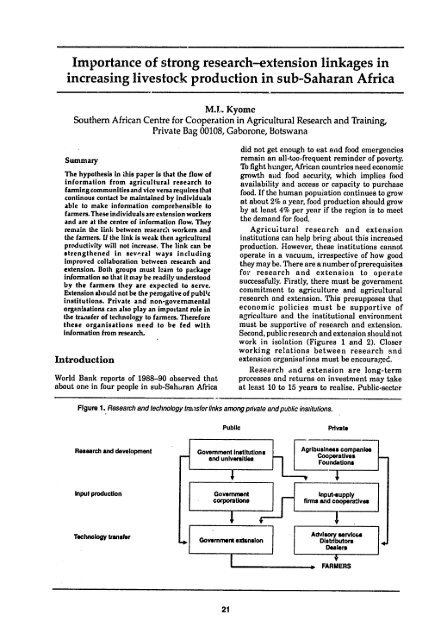aistand south~ern afrkca - (PDF, 101 mb) - USAID
aistand south~ern afrkca - (PDF, 101 mb) - USAID
aistand south~ern afrkca - (PDF, 101 mb) - USAID
Create successful ePaper yourself
Turn your PDF publications into a flip-book with our unique Google optimized e-Paper software.
Importance of strong research-extension linkages in<br />
increasing livestock production in sub-Saharan Africa<br />
M.L. Kyome<br />
Southern African Centre for Cooperation in Agricultural Research and Training,<br />
Private Bag 00108, Gaborone, Botswana<br />
did not get enough to eat and food emergencies<br />
Summary remain an all-too-frequent reminder of poverty.<br />
To fight hunger, African countries need economic<br />
The hypothesis In !his paper is that the flow of growth and food security, which implies food<br />
information from agricultural research to availability and access or capacity to purchase<br />
farmingcommunities and vice versa requires that food. If the human popuiation continues to grow<br />
continous contact be maintained by individuals at about 2% a year, food production should grow<br />
able to make information comprehensible to by at least 4% per year if the region is to meet<br />
farmers.These individuals are extension workers<br />
and are at the centre of information flow. They the demand for food.<br />
remain the link between research workers and Agricuitural research and extension<br />
the farmers. U the link is weak then agricultural institutions can help bring about this increabed<br />
productivity will not increase. The link can be production. However, these institutions cannot<br />
strengthened in sevral ways including operate in a vacuum, irrespective of how good<br />
Improved collaboration between research and they maybe. There are a nu<strong>mb</strong>erofprerequisites<br />
extension. Both groups must ]cam to package for research and extension to operate<br />
information so that It may be readily understood successfully. Firstly, there must be government<br />
by the farmers they are expected to serve.<br />
Extension should not be the perogative of publtc commitment to agriculture and agricultural<br />
Institutions. Private and non-governmental research and extension. This presupposes that<br />
organisations can also play an important role in economic policies must be supportive of<br />
the transfer of technology to farmers. Therefore agriculture and the institutional environment<br />
these organisations need to be fed with must be supportive of research and extension.<br />
information from research. Second, public research and extension should not<br />
work in isolation (Figures 1 and 2). Closer<br />
working relations between research and<br />
Introduction extension organisations must be encouraged.<br />
Research and extension are long-term<br />
World Bank reports of 1988-90 observed that processes and returns on investment may take<br />
about one in four people in sub-Sahuran Africa at least 10 to 15 years to realise. Public-sector<br />
Figure 1. Research and technology traosforlinks arnong pnvate and public institutions.<br />
Public Private<br />
Research and development Government Institutions Agribusiness companies<br />
and universities cooperatives<br />
F uroundationa<br />
Input production Government Input-supply<br />
corporatiort firms and €ooperaltives<br />
Goverment extmnsion Distributors<br />
Dealers<br />
21<br />
FARMERS

















